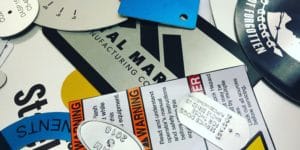Nameplates have many uses in various industries, from branding and product identification to safety labeling and equipment tagging. Whether you’re marking machinery, enhancing a product’s aesthetics, or ensuring compliance with industry regulations, choosing the right nameplate for its intended application is the first step in the process.
With so many manufacturing techniques available, it can be difficult to identify the best one for your needs. Factors such as durability, material compatibility, cost, and environmental conditions all play a role in selecting the ideal process. Additionally, certain processes work better depending on the material of the metal nameplate. This can affect the final look and longevity of the nameplate.
To help you decide, we’ve put together this guide outlining the top six nameplate manufacturing processes. By understanding the strengths and applications of each method, you’ll be better equipped to choose a nameplate that meets your functional, aesthetic, and durability requirements.
1.) Embossing
Metal embossed nameplates feature raised characters which are pushed up from the back of the material. Embossed nameplates also offer excellent legibility even when they are painted over or dirty and our metal nameplates are often used by the mining industry.
Embossing provides the following benefits:
- Long lasting identification (20+ years)
- Outdoors, inclement weather, etc.
- Company name, address, phone number
- Serialization
2.) Stamping
Stamped nameplates include characters and numbers that are recessed into the material with deep impressions. They are great at remaining legible even when faced with tough conditions.
Stamping provides the following benefits:
- Long lasting identification
- Company name, logo, address and phone number
- Serialized and variable data
3.) MetalPhoto
MetalPhoto is a photosensitive anodized aluminum used when long-lasting identification is desired. This unique process seals an image inside of an anodic layer in the aluminum. In short, MetalPhoto is fully customizable. It also handles any design, text, logo, or image. In addition, it can be more cost-effective than other processes such as engraving.
MetalPhoto provides the following benefits:
- Resistance to corrosion, fading and abrasion
- Rated for 20+ years outdoors durability
- Features any image, design, or information
- Support for barcodes for easy scanning and tracking
4.) Screen Printing
Instead of using a stamp or die to embed information, screen printing applies durable ink on the surface of the metal nameplate. These nameplates have a stand-out look, and can be made with full color designs.
Screen printing provides the following benefits:
- Fully customizable – full color
- Company name, logo, address, phone number
- Serialization/Barcodes/Variable Data
5.) Etching
Etched nameplates use a unique indentation process of cutting into the metal nameplate’s surface using a special chemical or laser process. With the option for etch and fill, etched nameplates also feature color customization.
Etching provides the following benefits:
- Etch and fill process for color
- Company name, logo, address and phone number
- Wide variety of materials and thicknesses
6.) Engraving
Engraving uses a special machine to carve out the information or design into the metal material. This is a very time consuming process, and also expensive. However, engraving allows for total customization as every character is cut individually.
Engraving provides the following benefits:
- Fully customizable
- Company name, logo, address, phone number
- Serialization, Variable Information
How to Choose the Right Nameplate Process
Selecting the right process to construct your metal name plates depends on various application-specific factors. Each manufacturing method offers unique benefits, so consider your project’s needs before proceeding.
Environment and Durability
Some nameplates are exposed to harsh environments, such as extreme temperatures, chemicals, or abrasion. Processes like photo anodizing, engraving, or etching provide excellent durability in these situations. These long-lasting options are often preferred for outdoor use or heavy industrial settings.
Material Requirements
Different processes work better with certain materials. Stainless steel, aluminum, and brass are common choices, but not every process suits every material. For example, photo anodizing works only with aluminum, while stamping or laser marking can be applied to a broader range.
Detail and Design
Laser marking or photo anodizing might be a better fit if your nameplate requires fine details, such as barcodes, logos, or serial numbers. These processes allow for high-resolution marking that holds up over time.
Volume and Cost
Production volume plays a big role. Stamping and screen printing are often more cost-effective for high-quantity orders. On the other hand, laser marking or engraving is ideal for smaller runs or custom pieces.
Compliance and Standards
Certain industries require specific standards, such as MIL-STD-130 or UID marking. In these cases, a precise, compliant process like laser marking is usually necessary.
Work With a Trusted Nameplate Manufacturer
There are many processes used to add information to nameplates. Consequently, each has its own set of pros and cons. Some are more durable, and others are more customizable. If you still aren’t sure where to begin, your supplier can help point you in the right direction.
Metal Marker Manufacturing has decades of experience helping companies find the right process for their custom nameplates. Whether you need rugged durability, detailed designs, or strict compliance, we can deliver a tailored solution to match your specifications.
Contact us today to learn more or request a quote for your next nameplate project.
